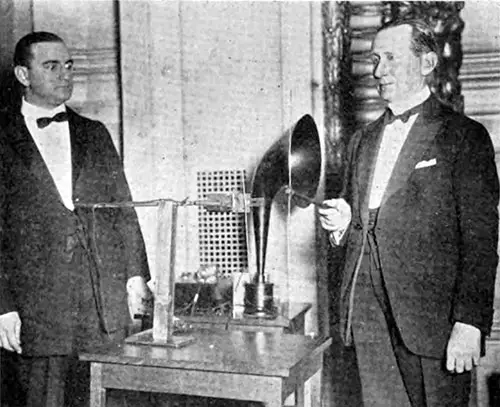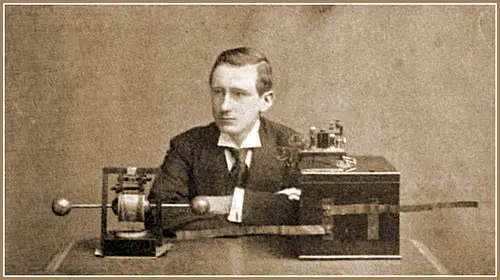Marconi’s Utilization of Short Waves - 1922
Marconi’s Utilization of Short Waves Means Great Advance in Wireless Art

Photograph of the apparatus which Senator Marconi used to demonstrate to the radio and electrical engineers his new discovery by means of which it is possible to send radio waves in any desired direction on short wave lengths. Photo by Kadel and Herbert.
In the picture Senator Marconi is seen standing beside his new '‘radio searchlight" instrument, holding in his hand a receiving rod, which corresponds to the receiving aerial. Doctor Alfred m. Goldsmith, professor of radio engineering in the city college, New York, is standing on the other side of the apparatus.
Ability to send direct projected signals will increase safety of life at sea and avert danger of vessels colliding in foggy weather.
Experiments in the application of the short wave have resulted in the discovery of a new field in the science of wireless communication which when further developed will increase the safety of life and property at sea.
The innovation, which was explained and demonstrated by Senator Guglielmo Marconi before the American Institute of Radio Engineers and the American Institute of Electrical Engineers, is based upon the ability to aim a wave in any chosen direction and send it straight to the receiving station for which it is intended.
The unlimited possibilities of this new phase of the radio art are very apparent and it does not require too keen a prophetic vision to foresee that the discovery presages a new wireless era and that its universal application is not far off.
For his demonstration before the radio and electrical engineers Senator Marconi used a miniature wireless set, a photograph of which is shown on this page, and sent signals in loud, clear notes across twenty feet of space on a wave of only one meter.
The engineers who witnessed the performance were surprised not only at the precision with which the signals were directed, but also at the perfect results achieved on so short a wave length. Illustrating the high development of which the short-wave field is capable Senator Marconi stated that on waves three and a half meters in length he had sent signals nearly one hundred miles in a desired direction.
These results were achieved by the use of a reflector apparatus for the sending of the wave which is caught at the receiving end on a horizontal metal standard.

Guglielmo Marconi and His Wireless Apparatus, 1897. Publicity Photo in a Magazine of British-Italian Radio Entrepreneur Guglielmo Marconi With His Early Wireless Radiotelegraphy Transmitter and Receiver, Invented Around 1895. On the Left Is His Spark Gap Transmitter, Consisting of a Dipole Antenna Made of Two Brass Rods With a Spark Gap Between Them, Which Transmits Pulses of Radio Waves Spelling Out Text Messages in Morse Code. On the Right Is His Receiver, Consisting of a Coherer Which Rings a Bell When It Receives the Dots and Dashes of Morse Code the Bell and Batteries Are in the Box. GGA Image ID # 1cf8dab9a6
This reflector is semi-circular in shape and is covered with wires. When its open side is turned toward the receiving station the signals are strong and clear, but when turned away the signals become almost inaudible.
It will be readily seen how this apparatus lends itself to use on ships at sea. Equipped with such an instrument a vessel can send out its own shafts of radio waves and receive them back with great accuracy.
Tests have shown that the course of the waves do not vary more than one-quarter of a degree according to the compass. Therefore by utilizing this system a ship can “feel” its way safely through the most dangerous fogs and treacherous channels because the captain can always be certain of his position.
Trials are now being carried out by Mr. C. S. Franklin of the British Marconi Company. Describing the apparatus and its working Senator Marconi said: “The transmitter and reflector, revolving, act as a kind of wireless lighthouse or beacon, and, by means of the revolving beam of electrical radiation, it is possible for ships, when within a certain distance, to as certain, in thick weather, the bearing and position of the lighthouse."
“The attenuation of these short-waves over sea is so surprisingly regular that a little experience enables distance to be judged by the strength of signals, and this can be measured by means of a potentiometer.”
Senator Marconi said that he believed the same system could be applied to ships at sea, so that collisions would be avoided in thick weather, and it would be unnecessary to send out the famous SOS call for help.
“It seems to me,” he declared, “that it should be possible to design apparatus by means of which a ship could radiate or project a divergent beam of these rays in any desired direction, which rays, if coming across a metallic object, such as another steamer or ship, would be reflected back to a receiver screened from the local transmitter on the sending ship, and thereby immediately reveal the presence and bearing of the other ship in fog or thick weather.
"Marconi’s Utilization of Short Waves Means Great Advance in Wireless Art," in The Nautical Gazette: America's Oldest Shipping Weekly, Volume 103, No. 1, Whole No. 2654, 1 July 1922, p. 9.
